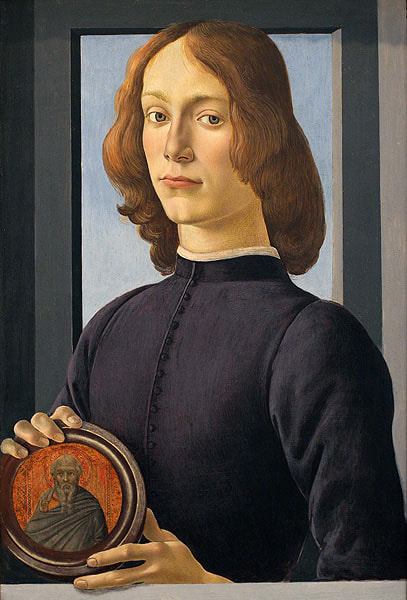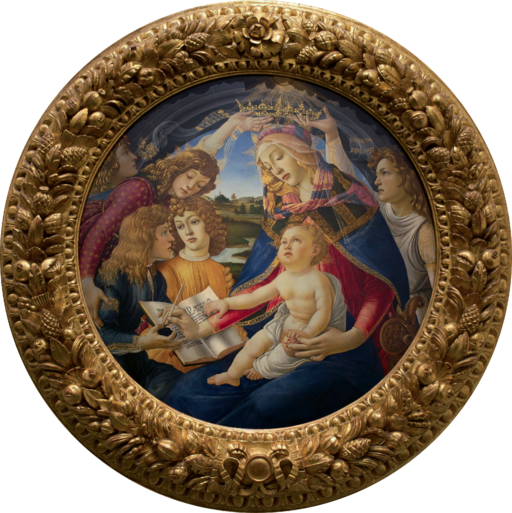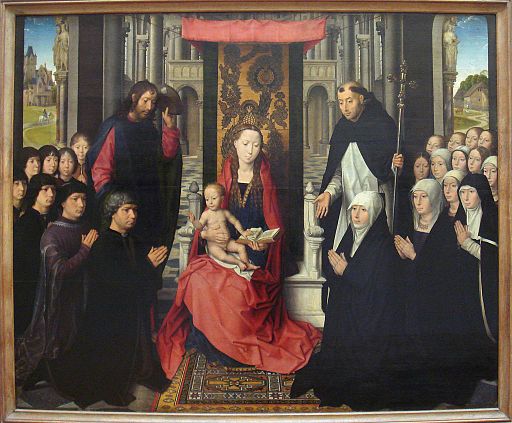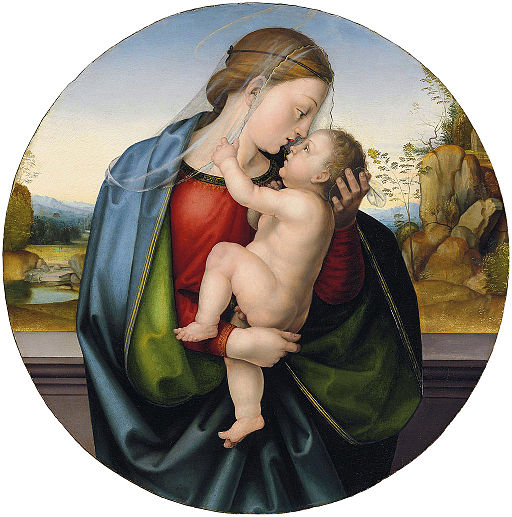Years 1480-1499
1480 The Image Holder
2021 SOLD for $ 92M including premium
The earliest is a 58 x 44 cm tempera painted around 1474, kept in the Uffizi Gallery. The added element is a gilded gesso medal bearing the effigy of Cosimo de Medici. The second, 58 x 39 cm tempera painted around 1480, will be sold by Sotheby's in New York on January 28, lot 15. Its added element is an icon of an elderly bearded saint painted on a gold background.
In both cases, there is no doubt that Botticelli designed and made the recess in the wood to place the insert. The position of the fingers around the added object is very precise. However, we can legitimately question if the currently inserted piece is original.
Cosimo's medal probably meets the artist's original intention. The Quattrocento portraits are painted with great care in the physiognomy, but also with elements that symbolize the social position, character or life of the model. The Lady with an Ermine painted by Leonardo in 1489 is a perfect example. The medal inserted in Botticelli's painting is a tribute of the model to the founder of the political power of the Medici.
The image of the bearded saint is an authentic fragment of a Sienese painting from the Trecento. The absence of an attribute to identify the saint is an anomaly if we consider the importance given to it by its holder. It may have been inserted later to replace another detached or damaged image.
Beyond these doubts, both paintings are direct witnesses of the iconographic inventiveness of one of the greatest masters of the Quattrocento.
The portrait of the young man holding the icon is in an exceptional state of conservation. This unidentified prince is sympathetic by his desire to have his medallion admired. His attitude is straight. The dark mauve pigment of the tunic is luxurious and rare. The December 4 press release reveals an estimate in excess of $ 80M. The image is shared by Wikimedia.
Madonna of the Magnificat by BOTTICELLI
1
1481 masterpiece
Uffizi
Tondi were a fashion of the time for a private devotion and contemplation above eye level. Botticelli managed to have the lines modified to match a perfect view in that position.
The Madonna and Child are surrounded by five angels, two of them holding a crown over Mary's head. The Child raises his head to look at the crown and puts his hand on an illuminated book. The text of the book is identified as two canticles from the Gospel of Luke.
The Madonna holds a quill to write the left page which is the opening of the Magnificat also referred as the Song of Mary. The left hands of Mother and Child join to hold a pomegranate, the heart shaped symbol of the Passion. That co-ordinated movement of the two hands of the two leading characters is beautiful.
2
later 1480s Replica
2022 SOLD for $ 48M by Christie's
This tempera, oil and gold on a 63 cm tondo panel is largely autograph as evidenced by underdrawings and pentimenti revealed by infrared and x-ray inspection. The style of the lines argues for a date in the later 1480s.
The composition is simplified to match with the smaller format. The two angels and the crown have been removed, making more mystical the raised gaze of the Child. The three remaining angels are now winged.
A selection of works from the collection of the late Microsoft co-founder Paul Allen—including a work by Cézanne with an estimate in excess of $120m—are on show at @ChristiesInc London this weekend prior to their sale in New York next month. https://t.co/jcI3Jaz2n9
— The Art Newspaper (@TheArtNewspaper) October 15, 2022
masterpiece
1482 Primavera by Botticelli
Uffizi
1480s Head of a Bear by Leonardo
2021 SOLD for £ 8.9 by Christie's
On July 8, 2021, Christie's sold for £ 8.9M the drawing of the head of a bear made by Leonardo in the 1480s, lot 20. This piece is a silverpoint on 7 x 7 cm pink-beige prepared paper with top corners cut.
No bear is known to appear in Leonardo's paintings. Nevertheless this drawing was certainly used as a preparatory sketch for the pet stoat when he designed the Lady with an ermine at the end of the same decade.
#AuctionUpdate Leonardo da Vinci's 'Head of a bear' achieved £8,857,500 in The Exceptional Sale, setting a new #WorldAuctionRecord for a drawing by the artist. The drawing is an exquisite demonstration of #LeonardodaVinci's unsurpassed mastery as a draughtsman. #ClassicWeekLondon pic.twitter.com/d0Ja2Ualub
— Christie's (@ChristiesInc) July 8, 2021
Chenghua - Imperial Chickens
2014 SOLD 280 MHK$ including premium
The best period of Chenghua porcelains is the second decade of his reign. Improvements are made to the choice of materials, enabling a higher temperature. The apex of any ceramic art is then achieved with a dense paste, a transparent and robust glaze and an extraordinary tactile effect.
The doucai color, started under Xuande, also gets some dramatic progress under Chenghua. Mixing enameled colors over the glaze allows a wide range of shades.
The figures of Chenghua ceramics are simple and naive. However, his chicken wine cups had an almost mystical reputation. The rooster is the emperor, and the hen protecting her chicks is his favorite concubine. It is an opportunity fir the historian to remind that Wan Guifei herself intervened to improve the quality of imperial porcelains.
One of these wonders is in perfect condition, on a pristine white background, without any crack or scratch. This piece 8.2 cm in diameter is decorated underglaze in cobalt blue and multicolored on its surface.
It was sold for HK $ 29M including premium on April 27, 1999 by Sotheby's, purchased at that sale by Eskenazi. It is estimated HK $ 200M, for sale by Sotheby's in Hong Kong on April 8.
POST SALE COMMENT
The absolute pinnacle of the art of porcelain was achieved by the Chinese Imperial pieces of the second part of the reign of Chenghua. This cup was sold for HK $ 280M including premium.
I invite you to play the video shared by Sotheby's :
The Palace Bowls of the Chenghua Emperor
2013 SOLD 140 MHK$ including premium
During this reign that lasted 24 years, the porcelain workshops of Jingdezhen had an intense activity, which can be divided into three phases.
The blue and white of the beginning looks similar as Yuan and early Ming styles. The first major technical innovation is then the doucai, by which other colors could be added through a second firing.
And suddenly, about the 17th year of his reign, the unique technique of the so-called Chenghua palace bowls is launched. The porcelain is back to blue and white, but its tactile quality is extraordinary, comparable only to the Ru porcelain of the Northern Song, 380 years earlier.
Chenghua palace bowls are decorated with delicacy and simplicity, with flowers or fruits of botanical accuracy. On 7 April 2011, Sotheby's sold HK $ 90M in post sale a bowl 15 cm in diameter decorated with fruit and leaves of melon.
On October 8, Hong Kong, the palace bowl to be sold by Sotheby's, similar as the above in shape and size, is decorated inside and outside with humble musk-mallows. Also same as the melon bowl, it wears the Imperial mark. Expected beyond HK $ 80M, it will be described in a separate catalog. Here is the link to the home page of the sale.
The Ru of the Song had been interrupted by the Yuan invasion after only a few years. Similarly, the production of Chenghua bowls did not survive his reign. Easier to execute, the doucai had a great future and is one of the major steps that lead to the perfection of colors of the falangcai under the Qing.
POST SALE COMMENT
Chenghua palace bowls are among the greatest wonders in the history of art. This specimen was sold for HK$ 140M including premium.
Chenghua - Perfect Tactility of Ming Bowls
2011 SOLD 90 MHK$
The "palace bowls" were produced for a very short period not exceeding 7 years, from 1481 to 1487 in our calendar at the end of the reign of Chenghua, the seventh emperor. This utensil is by nature an object to be touched. These Chenghua bowls reach a perfection of tactility that will never be exceeded.
They are very rare, and the copy for sale by Sotheby's in Hong Kong on April 7, estimated HK $ 80M, takes its place among the masterpieces of Chinese porcelain.
Measuring 15 cm in diameter, it is inscribed with the six-character mark of Chenghua and decorated with melon vines including leaves and fruits.
POST SALE COMMENTS
1
Perfection of manufacturing and scarcity were not sufficient arguments to justify the estimate. Unsold.
2
A later buyer let this bowl win its rightful place in the cultural hierarchy of the results.
The press release of Sotheby's indicates that it was sold HK $ 90M privately after the sale.
Traditionally, such announcement includes fees.
1486 The Triumphs of Mantua
2020 SOLD for $ 11.7M including premium
One of his most important achievements is the series of the Triumphs of Caesar. Nine tempera paintings were made in a unique format 268 x 278 cm. A tenth image is known from an engraving. The realization lasted several years. It was sufficiently advanced in 1486 to be praised by the Duke of Ferrara.
These paintings were conceived as a narrative suite, with a homogeneity in the position of the light. We do not know however in what chronology they were painted. Acquired by King Charles I, this monumental set is exhibited in a row at Hampton Court.
A preparatory drawing for the second opus has just surfaced. Measuring 26.6 x 26.6 cm, it is an exact 1:10 scale. The hero on horseback passes between two monumental statues which are an Aesculapius standing on a carriage and a head of Cybele.
This drawing has a role of demonstration before the realization of the painting. The inscriptions identifying Aesculapius at the top of the carriage and Alexandria under the round tower were not copied in the final work. The banner texts have changed. Divo Iulio Aug ... became Imp Iulio Caesari ob Galliam devict in a reference to the First Italian War. A competent condottiero, the marchese Francesco II Gonzaga was in 1495 the governor general of the armies of the League of Venice against the new 'Gallic' invader.
The infrared inspection of the drawing, carried out by Sotheby's, revealed important reworks skillfully masked in the line, confirming that the work is autograph. The tall Aesculapius thus hides a previous Apollo whose much smaller dimension could be mingled with the characters of the action. The invocation of Aesculapius in a triumph, maintained in the painting, is a fancy.
This drawing is estimated in excess of $ 12M for sale by Sotheby's in New York on January 29, lot 19. Please watch the video shared by Sotheby's in which the artwork is commented by the specialist Cristiana Romalli who was the discoverer of the hidden figures.
#AuctionUpdate: Andrea Mantegna’s only preparatory drawing for one of the canvases in the Triumphs of Caesar, realizes $11.7 million - a new record for a drawing by the artist at auction, and the 5th highest price for a drawing ever at auction pic.twitter.com/p6e3THFEU6
— Sotheby's (@Sothebys) January 29, 2020
1490 Pentecost by a follower of Memling
2023 SOLD for £ 7.9M by Sotheby's
Mary is looking down at the open book on her lap. The gaze of the men is more or less turned upwards while a haloed dove is flying down. A couple of donors has been added. The composition is complex with a large fireplace, a door opening to a corridor and a yard through the windows.
A German painter working in Bruges from 1465 to his death in 1494, Hans Memling had begun his career in Brussels as an assistant to Rogier van der Weyden. A Madonna and Child surrounded by a praying crowd had been painted by Memling around 1488-1490.
The Rapaert Pentecost could be a prototype of the Pentecost theme painted in Bruges ca 1490 by a follower of Memling. Scholars consider a parallel with the half length donor portraits of Baroncelli husband and wife, painted in the 1490s by an unidentified master, possibly a son of Petrus Christus. Baroncelli was the operator of the Medici bank in Bruges.
This oil on panel 126 x 102 cm was sold for £ 4.2M by Christie's on December 7, 2010, lot 8. It will be sold by Sotheby's on July 5, 2023, lot 7. Its condition is exceptional. The image is shared by Wikimedia.
for reference
1488-1490 Madonna and Child by Memling
Louvre
1493-1495 The Florentine Grace of Sandro Botticelli
2013 SOLD 10.5 M$ including premium
Botticelli's life is poorly documented, but his passion for his city, Florence, is the thread.
On January 30 in New York, Christie's sells a Madonna and Child with the young St John. This tempera on panel is estimated $ 5M. Waiting for the catalog, here is the link to the article shared by Artdaily when this painting was offered for sale at Maastricht in 2010. Of small size, 48 x 38 cm, it was designed for private devotion.
Botticelli's art is not narrative. The scene is by evidence located in Florence, and is not a Biblical story. The presence of John is only meaning that he is the patron saint of Florence. The three characters are graceful and communicate together with ardor. The faces are beautiful.
This work is dated around 1493-1495, the period of transition between the principate of Lorenzo de' Medici and the theocracy of Savonarola. The legend that he had himself brought his secular works in the Bonfire of the Vanities is not confirmed by Vasari, but it seems certain that his career as an artist became difficult afterwards.
POST SALE COMMENT
This small painting typical of the emotional art of Botticelli was sold $ 10.5 million including premium.
The image is shared by Wikimedia.
mid 1490s Virgin and Child at the Time of Savonarola
2013 SOLD 13 M$ including premium
The likely date proposed by the auction house, the mid-1490s, is the era of the iconoclastic dictatorship of Savonarola, the preacher of repentance.
The relationship between art and Christianity were already an intense concern in Florence at the end of the glorious principate of Lorenzo de' Medici. The dying Lorenzo had doubts about the merits of his work, and chose (but unsuccessfully) Savonarola as his last confessor.
Savonarola, whose memory of his bonfires horrifies the art lovers of today, was chasing the vanities. Botticelli's mythological works have sunk therein. But he did not reject art when it glorified the Christian virtues.
Baccio della Porta, born in 1472, is a young artist whose skills are already recognized. Becoming an avid follower of Savonarola, he directs his art in accordance with the theocratic vision of his guru of whom he will also execute a very famous portrait.
It was only in 1500, when Baccio became the Dominican friar Fra Bartolomeo (or Fra Bartolommeo), that he will abandon his activity as an artist for a long period, before brilliantly resuming his brushes at the time of Raphael.
The tondo for sale is a very charming example of Christian art. The naked child rises to the mother's neck for a kiss. Empathy is intense between mother and child. The tondo format, as circular as a halo, contributes to the perfection of this nicely composed image.
POST SALE COMMENT
Deserved result for this very attractive painting by Fra Bartolommeo: $ 13M including premium.
Size of the tondo : 65 cm diameter.
The image is shared by Wikimedia.
1490s Michelangelo after Masaccio
2022 SOLD for € 23M by Christie's
Previously attributed to a later minor artist or to the school of Michelangelo, a drawing 33 x 20 cm in pen, two shades of brown ink and brown wash was attributed for the first time in 2019 to the master by an expert at Christie's. Its availability on the international art market had been delayed by a French export ban which is now lifted.
The main character is a full length fleshy young nude in a shivering position that copies the man in the right in Masaccio's Carmine Baptism. Two lesser figures comfort him from behind in a softer hue. Some relief effect is added by skilled hatchings. Remorses have been made with a dark ink, confirming that this piece was a study for a painting by the young master.
This drawing was sold for € 23M by Christie's on May 18, 2022, lot 1. Please watch the video shared by the auction house.
First it was Raphael making $38m; then da Vinci made $11.8m; now a rediscovered Michelangelo is looking for $33m @christiesparis this Mayhttps://t.co/oXmswtdga3 pic.twitter.com/BNt64YAPzg
— LiveArt (@artmarket) April 5, 2022









